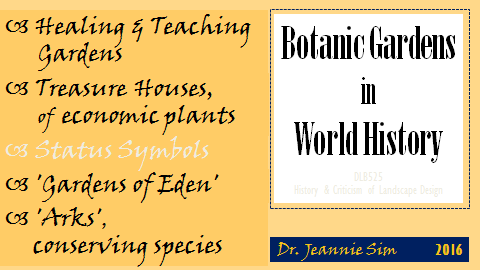Defining Terms
The defining terms discussed here are botanic gardens, arboretum and herbarium.
This is the first page in the website’s contextual section which is relevant to all three botanic treasures sites.
Placing the story of botanic gardens in historical context, there is a downloadable file of the Talk on Botanic Gardens in World History at the bottom of the page.
What is a botanic garden?
Botanic gardens are museums of living plant collections.
They are richly endowed with scientific, horticultural, historic, social, aesthetic and design values. The plants themselves, the culture of these collections and how we use these places are all involved in sustaining these values. Weakening any of these foundations threatens the place as a whole. The famous Kirstenbosch National Botanic Garden in South Africa reminds visitors that a botanic garden is much more than just a park. “Botanic Gardens are living museums, They contain collections of plants that are used for display, scientific research and education, and play a vital role in the conservation of plant biodiversity.” [Jan 2017 visitor guide]
The care and protection (maintenance) of the plant collections is a practical tradition of intangible cultural heritage that combines horticulture and design.
The curated presentation and interpretation of the plant collections to the community encourages many sorts of learning and increases our appreciation of the nature/human connection. Specialised scientists, such as botanists, ecologists and environmental scientists are another user group whose research outcomes benefit the world.
The visitor experience in a botanic garden includes visual pleasures, intellectual stimulation and increases well-being (physically and emotionally). Botanic gardens heal the spirit, mind and body. They provide enriching healthy places for family enjoyment with substantial opportunities to discover nature and science.
Botanic gardens are treasure houses of plants. They contribute to biodiversity and long-term conservation of the world’s natural resources. We need them. They are our responsibility to protect so future generations can benefit as we do.
Lift your spirits and visit one of Brisbane’s Botanic Treasures today! Or explore this website for virtual pleasures!
What is an Arboretum?
An arboretum is a botanical collection of woody plants, mostly trees but some shrubs are woody as well. Sometimes the terms botanic garden and arboretum are used interchangeably, especially in the USA. However, in the purest sense, an arboretum is an arrangement of just trees or large woody shrubs that resemble small trees. And some trees with multiple trunks (Mallee habit in Australian terms) can resemble shrubs, for instance Lagerstroemia indica (crepe myrtle) can sucker around the first trunk and look more like a large shrubby cluster.
There are also specialised collections of trees which expand our defining terms list, for example Pinetum (a collection of gymnosperms or conifers) and Palmetum (a collection of palms). Sometimes these plant collections are compartments within botanic gardens and are called up using these terms. For instance, there is an arboretum within Royal BG, Kew.
What is an Herbarium?
Also called a Hortus Siccus. “A collection of dried pressed plants, mounted on sheets of thin card, accompanied by data labels and stored in pest-proof wooden or metal cabinets. Smaller organs, including pollen grains, are perfectly preserved in this way, and many other features of the plant (e.g. anatomy, morphology, and chemistry) may be retained virtually unaltered.” [Source: Blackmore, Stephen (consultant editor) 1984. The Penguin Dictionary of Botany. London: Penguin Books, pg.172.
There are many purposes of an herbarium, which acts as an essential reference source often assisted by a scholarly specialist library. Botanists, including taxonomists and ecologists, use their herbaria to help publish essential descriptions of plants in regional “Flora”, vegetation analyses and so much more. For example the second Government Botanist in Queensland, Frederick Manson Bailey published his extraordinary Flora in seven volumes: Bailey, F. Manson (1899-1902), The Queensland Flora: with plates illustrating some rare species, Brisbane: H.J. Didams & Co.
To know more about the Queensland Herbarium, based within Brisbane Botanic Gardens, Mt. Coot-tha, here is the link page: >>> https://brisbanebotanictreasures.info/mount-coot-tha-botanic-gardens-brisbane/mount-coot-tha-botanic-gardens-botanical-collections/
![]()
FOR MORE, PLEASE DOWNLOAD THIS ILLUSTRATED TALK: >>> WORLD HISTORY botanic gardens 6pages


![]()
What else would you like to explore? We have four other context themes:
Our botanic treasures in Brisbane ~ about this new interpretation website
Tropicalia: landscape design in warm climates
Bush-houses: shade gardening and garden architecture
Planting Design for Botanic Gardens: where design meets science!
Applied Science: observation, experimentation, distribution in botanic gardens
Sharing Knowledge: education, promotion and publications in botanic gardens
